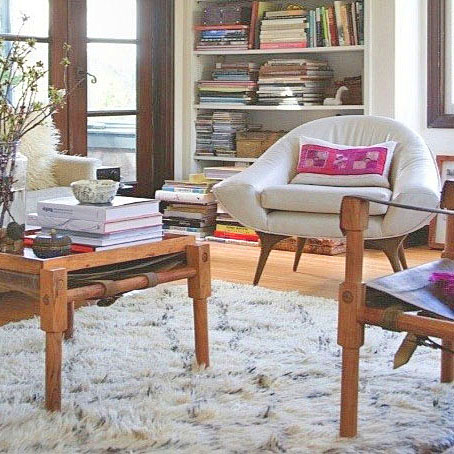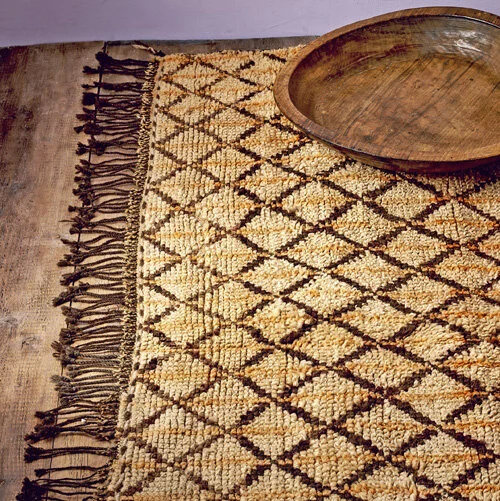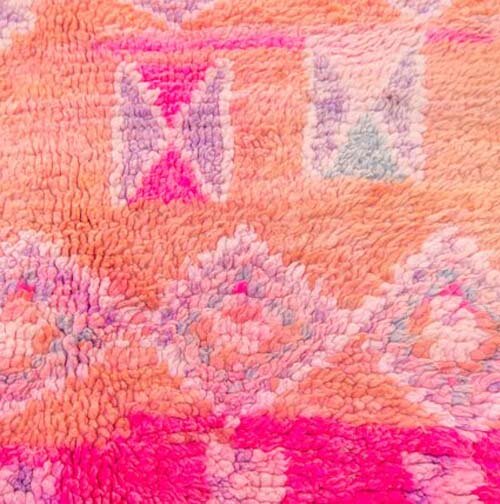Tips for Buying your Berber Tribal Rug
Obsessed with all things Moroccan
Moroccan rugs – particularly one-of-a-kind treasures - are highly sought after and continue their run of popularity across most interior and home decor styles. Provided you pick the right rug. Because, along with their lively reputation has sadly come a slew of fakes, new rugs marketed as old ‘tribal’ pieces, poor quality pieces, poor advice, and rugs that simply aren’t authentic. We care about this because old, authentic Berber rugs - those eccentric, artistically demanding carpets - deserve recognition and credit and their buyers deserve to know that what they are buying is credible and true
Age matters
The term vintage is these days widely used to describe a whole host of rugs. To us, it means trustworthy rugs dating from, say, before the 1990s. And, if a rug is truly vintage or mid-century there is one important thing for you to to look for and to value - wear
An original rug that has been used in a Berber home or tent is likely to have some marks, damage, henna stains, drops of candle wax, unravelling at the ends (the hardest parts to repair on a vintage rug are the ends and edges), and so on. Very old rugs are likely be well-worn, probably featuring plenty of restoration. Some of which might be quite basic. Sun fading may be irregular or only in patches rather than across the full rug. If a rug is called vintage yet has no sign of a past life, it's likely to be new, so look for the original patina of a life well lived. Then you will be on your way to finding an authentic old rug
Watch out for antique washes
In Morocco, there’s plenty of know-how on how to produce and sell ‘aged’ rugs, adjusted to the needs of the market. Woven in what is often termed cooperatives, nowadays hundreds of producers create new rugs that are washed, faded and worked on to then be marketed to unsuspecting international buyers or traders as old. They can be convincing and often only someone who really knows Berber rugs will be able to tell the truth from the copy
Tall tales about vegetable dyes ...
Synthetic dyes have been available in remote souks for decades, supplementing the natural dyes used by Berbers. In fact, even in the early 20th Century women probably preferred manufactured dyes as they were much easier to work with. This means that natural dyes are less common than you would think
Deep hues such as blue, aubergine, tangerine, and amber could be derived from natural sources and many years ago were widely used. In the cold north eastern regions the Middle Atlas mountains of Morocco carpets were woven to reflect the neutral cream and brown hues of the natural wool of the family’s sheep. In the lower southern regions saffron and yellow hues were used a lot
However, the faded baby pink, aqua, blush and light pastel tones were not widely used in authentic Berber carpets - they are usually colours that have been introduced recently to cater to western tastes, with rugs faded with chemicals to give them a older look
Expertly woven rugs with a beautiful texture, plush wool, and personal symbols aren't devalued because of the absence of natural dyes -in fact shimmering colour is a hallmark of Berber rugs and many of these wonderful hues could only have been achieved with high quality synthetic dyes
Understanding Berber culture
Many lay people without deep knowledge of Berber tribal rugs have entered the international trading markets. Many rely on the shops in the tourist centres in Morocco, such as Marrakech, Essouira or Fez, to supply them with stock. At times misunderstandings arise
One example is the Beni Ouarain rugs that have been in such great demand to the extent that ‘Beni Ouarain’ is now used as a byword for all Moroccan black and white rugs. Although, they are not the same. In fact, Beni Ouarain carpets were woven only by the Berbers of Morocco’s north-eastern Middle Atlas Mountains, and nearby neighbouring tribes. The Beni Ouarain are in fact a confederation of seventeen specific Berber tribes, who are believed to have been living in the region since as far back as the 9th century
And, while 'Beni' means ‘sons of’ and has been used for centuries for certain Berber and Arab tribes, even that word is commonly mis-attributed to create a provenance for rugs. For example, there’s a town in the Middle Atlas mountains called Mrit. It’s wool trading area, and lots of general new commercial rug weaving takes place there. Now, those new rugs from the area are being attributed to the 'Beni Mrit' – a tribe that has never existed
As so many rugs are now sourced in the souks of Marrakesh (very few people can really get out into the isolated Berber villages. It’s a tough, specialist activity!) it's becoming standard to attribute tribal rugs to the nearby High Atlas mountains. However, the thickest, most plush original rugs (Beni Ouarain, Beni Mguild) have always been woven far, far away from Marrakesh and rarely end up there, starting life in the cold mountains in the north east. Most of what is woven near to Marrakesh is woven quickly to sell to western buyers
Some tourist rug souks also have a tendency to date rugs as much older than they are. Genuine mid century Berber rugs are now really very rare, and it's common to see newer rugs sold as old
All this points to the need to seek out those with an intimate knowledge of Moroccan Berber history, and who know how and where the many different tribes wove
Genuinely old rugs have a lasting value
Availability of old rugs is naturally limited, and the demand of the past few years has visibly reduced the supply. Vintage ones are becoming scarce and more expensive. Good pieces might enjoy strong price increases in the future
An old piece is likely to have a spontaneous and archaic, or a very detailed and skillfully produced, design often featuring irregularities and special touches added by the weaver just for her, for her very personal carpet. A carpet woven by a woman for her own use would have been crafted with care and pride, using the best wool she could afford. A good rug is made from good resources
Your Moroccan textile specialist will know the local marketplace and will venture into Berber territory to where best rugs can be found. In my long experience, that is out in the mountains and on the plains
At Maroc Tribal we are happy to offer genuine and gorgeous pieces to clients worldwide. As a Moroccan of both Arab and Berber decent myself, it's my privilege to share my culture and history, exploring Berber culture and immersing myself in the often mysterious world of Berber textiles
Always feel free to ask us as many questions you like!
Mo
PS. People often ask us who else we think has a great take on the world of Berber rugs. For my part, I've always admired Berber Arts








